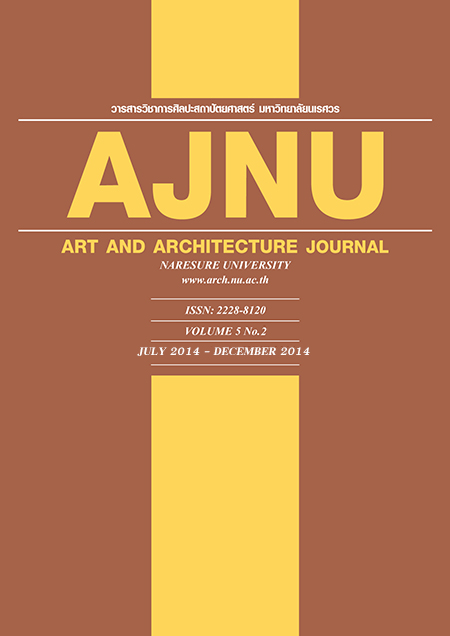แนวทางการปรับปรุงและจัดทำต้นแบบที่อยู่อาศัยที่เหมาะสมกับงบประมาณ สำหรับคนพิการ และผู้สูงอายุ กรณีศึกษา เทศบาลนครพิษณุโลก Design Guidelines to Improving and Making Prototype Housing that base on Limited Budget for Disabilities Persons and Elderly: A Case
Main Article Content
Abstract
การศึกษานี้เพื่อหาแนวทางในการปรับปรุง และจัดทำต้นแบบที่อยู่อาศัยให้กับผู้สูงอายุ คนพิการ ที่ยากไร้ ในเขตเทศบาลนคร
พิษณุโลกอย่างเหมาะสมกับงบประมาณ ตามที่เทศบาลฯ ได้บรรจุโครงการพัฒนาที่อยู่อาศัยของผู้สูงอายุ คนพิการ ที่ยากไร้ ไว้ใน
แผนพัฒนา 3 ปี (พ.ศ.2556-2558) การวิจัยได้ศึกษากลุ่มตัวอย่างที่อยู่อาศัยของผู้สูงอายุ คนพิการ ที่ยากไร้ ตามที่เทศบาลฯ ได้
คัดเลือกไว้ 20หลัง เพื่อทำการช่วยเหลือจริง ผลการศึกษาสามารถจำแนกที่อยู่อาศัยออกเป็น 5 รูปแบบ ในแต่ละรูปแบบมีแนว
ทางการปรับปรุง คือ 1)บ้านยกสูง มีใต้ถุน จำนวน 8 หลัง มีบริเวณที่เป็นปัญหาต้องปรับปรุงคือ ห้องน้ำ โครงสร้างพื้นชั้นบนที่ชำรุด
จนเคยเกิดเหตุพังลงมาทำให้ผู้สูงอายุที่ใช้อยู่ตกลงมาด้วย 2)บ้านเดี่ยวชั้นเดียวมี 4 หลัง และ 3)บ้านแถว1หลัง มีบริเวณที่เป็นปัญหา
ต้องปรับปรุงคล้ายกันคือ ห้องน้ำ และหลังคา 4) เพิงพัก มี 5หลัง ซึ่งทั้งหมดไม่ได้ตั้งอยู่ในที่ดินของตนเองจึงไม่สามารถใช้เงื่อนไขจาก
งบประมาณบ้านเทิดไท้องค์ราชันมาสนับสนุนได้ทำให้งบต้องจำกัด ที่อยู่อาศัยแบบเพิงพักนี้ต้องเร่งจัดให้มีห้องน้ำเพราะมีกรณี
ผู้สูงอายุยังไม่มีห้องน้ำไว้ใช้สอยอยู่ด้วย และ5)บ้านเดี่ยวสองชั้นมี 2 หลัง ปัญหาที่พบคือ ชั้นบนพังเพราะปลวกและพังเพราะวาตภัย
ทำให้ต้องปรับให้เหลือเพียงชั้นเดียว กรณีบ้านที่ประสบวาตภัยสามารถจัดสรรงบบรรเทาสาธารภัยมาช่วยเหลือได้ และด้วยเหตุที่
จำนวนผู้สูงอายุ คนพิการ ที่ยากไร้มีเป็นจำนวนมาก ทำให้งบประมาณในการปรับปรุงที่อยู่ต้องเฉลี่ยตามความเหมาะสม ในกรณีบ้าน
ต้นแบบที่ได้ศึกษาและพัฒนาขึ้นจึงเพื่อช่วยเหลือผู้สูงอายุ/คนพิการที่มีเกณฑ์พอช่วยเหลือตนเองได้ และได้รับความเดือดร้อนไว้อยู่
อาศัย สำหรับแนวคิดในการก่อสร้างควรใช้งบไม่เกิน80,000บาท/หลัง(ไม่รวมค่าแรง) โดยบ้านต้องรื้อถอน เคลื่อนย้ายได้ ในแผน
ระยะยาวการดำเนินงานควรอาศัยความร่วมมือจากหลายภาคส่วนในการช่วยเหลือสนับสนุนปัจจัยต่างๆ อย่างเหมาะสมต่อไป
The purpose of this study was to develop design guidelines for housing improvements, and to design a
prototype house for the social housing of poor, elderly persons, and persons with disabilities, in the Phitsanulok
Municipality, within appropriate budgetary constraints. This study was motivated by the Phitsanulok Municipality
having included in its 3 year development plan, for the years 2556 to 2558, a housing development project for
these purposes. Twenty examples of social housing currently available, selected by the Municipality for
improvement, were studied. The study gathered information about 5 types of housing included in the sample,
and the problems potentially faced when living in these houses. Eight of the houses were built on stilts, with
space underneath the living areas. Toilet facilities were identified as being sub-grade, and required
improvement, and the upper living space flooring was cracked and partially collapsed, creating a danger for the
elderly inhabitants. A further 4 single story, detached houses, were investigated, as well as one townhouse, all
of which required improvements to toilet facilities, and needed roof repairs. Two double-story detached houses
were found to have substantial termite damage and storm damage, which would require demolition of the
upper floor area and roof. Five other constructions, described as ‘sheds’, were located on land not owned by
the inhabitants, which placed them outside the reach of a Thai Government budget (known as the Ban Terd
Tai King Rama9 Project) allocated to the Municipality. A separate, but associated budget provided by the Thai
Government for public hazard relief, also allocated to the Municipality, is available, under which the storm
damaged house rectification could be undertaken.Nonetheless, despite the availability of funds under these
budgets, there were many elderly people, and those with disabilities, still in need of assistance in obtaining
appropriate housing. Therefore, the available budgets need to be allocated more appropriately. This lead to the
requirement to design low cost, cost effective social housing, and a design for a prototype house to achieve this
end was undertaken. The ideal house should be a moveable house built within a budget of 80,000Baht,
excluding the labour component. The house design should enable the elderly to be self-sufficient and
conveniently housed within their own community. An essential aspect is to ensure the cooperation with all
sections of the local community in placing and building these houses.


